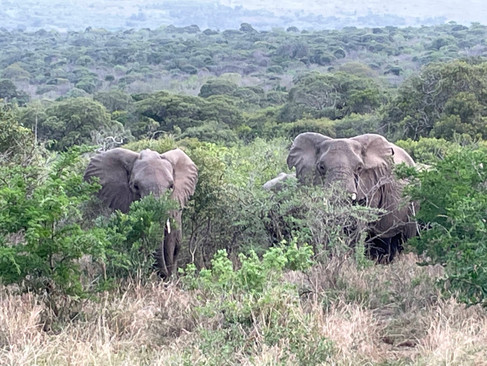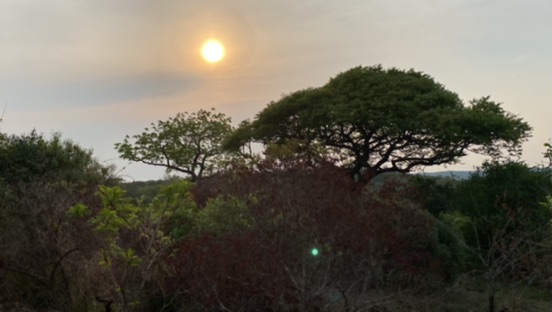Vacation Part II
- daramarkb
- Oct 31, 2022
- 4 min read
From Thonga Beach Lodge, we made our way to its sister lodge, Rhino Ridge Lodge, in the Hluhluwhe-iMfolozi National Park, about halfway from Kosi Bay to Durban. Another nice lodge -- not quite as harrowing a drive in, a more modern vibe than Thonga Beach Lodge and Pungwe. It is up on a ridge (hence the name) with stunning views over lush, green rolling hills. The landscape was much different that what we'd seen before. We were there for 2 nights with safari drives each evening and morning (like at Pungwe) with lots of time in between for sitting by the pool (yes - an infinity pool in the middle of a huge animal reserve!) enjoying the scenery.
We had a great safari guide, Tsibonelo or Tsibo for short (I'm sure I'm not spelling it right). Each ride, a friendly, loquacious, young German couple, Janine and Daniel, were paired up with us in the Jeep. Not much to say. I think the pictures will say it better than I could. Note though - Since in this park , the vegetation was so lush and thick, and the vehicles had to stay on the roads (no off-road trekking to search for or follow tracks or animals here), it was harder to find and see the animals up-close. But Tsibo wowed us each time with amazing sitings.
Found some dwarf mongoose one evening:
An entire herd of elephants is truly a sight to see. The adults really protect the little ones. See the tiny baby near the rear.
A baboon family hanging around with little ones playing:
The trees and sunsets deserve their own collage. There's something about a solitary tree in the savanna with an incredible, African sunset behind it.
The birds are amazing too.
On the second day, Matt and I had a chance to do a bush walk after our morning safari drive. We'd had great walks at Pungwe and we always enjoy walking "in the nature", as Ari's friend Carlos would say, so we jumped at the chance. We met our guide, Nunu and headed out. It was impossible not to notice that Nunu was barefoot. Now that is a guy who is comfortable in the bush!
Just like in our previous walks, Nunu pointed out little things -- plants, insects, tracks and more -- that you'd never get from the Jeep. A little ways in, we came across a couple giraffes, up close and personal. From that perspective you could really see how big and powerful these animals really are. Nunu also found a couple trap-door spider nests. The spiders dig a perfectly round, cylindrical hole down into the ground for their nest and they cover it with an air tight lid made of dirt, grass and web. It is so tight, it pops when you pry it open as if you were opening an air-tight jar of pickles! I don't know how the spiders can pull it down so tight from inside the nest. Incredible! Another highlight similar to the dung beetle.
Not long into the walk, Nunu picked up signs that elephants had been through recently -- footprints the size of dinner plates (the dirt was hard packed so these were usually only partial prints), occasional squiggles in the dust left by the trunks that they dangle as they walk and, unmistakable piles of poop that, even to our untrained eyes, looked pretty fresh. After a little more hiking, we could spot the elephants off in the distance.
Nunu, knowing the terrain, led us off to the left, rather than towards the elephants. Evidently there was a small river and lots of lush grass and he predicted the elephants would head that way. We made our way through some more of the dry brush (quick aside: walking through the bush is not difficult -- the animals make paths and follow them regularly so that are well worn. They end up just like the paths on Bald Pate Mountain or any other park back home) and as we got close to the river, the vegetation abruptly changed to a tropical vibe.
Nunu signaled us to stop and be quiet at a spot on the river bank with a good view of the tall grass. Sure enough, after a few minutes of waiting, the herd of elephants could be seen tromping through the grass, enjoying the lush vegetation. Wow.
If that wasn't enough, later in the walk we heard a bleating sound as we came to a small bluff overlooking a wide, muddy spot in the bend of a small stream. A water buffalo (one of the Big 5) was having a nice mud bath and behind him was mom rhinoceros with a baby (not a baby, baby -- Nunu estimated 6-12 months old). The mom was having a nice rest in the mud and the baby wanted to suckle (they usually do this until they are 18 months old or so) but the mom was having none of it. This was the source of the bleating sound. Once the water buffalo saw us, he got up and moseyed off into the brush on the far side of the stream. It took the rhinos a little longer, but they headed off before too long, too. Nunu thought that if the water buffalo hadn't been there, the rhinos would have hung out longer because they would not have realized that we were there since their eye sight is pretty bad and Nunu had had us stay downwind.
So, all in all, a pretty incredible bush walk to go along with our safari drives.
Unlike all the other rhinos we'd seen, the rhinos in this park do not get their horns trimmed. This makes them very attractive targets for poachers. Since, ounce for ounce, rhino horn is more valuable than gold, diamonds or cocaine, organized crime syndicates have gotten involved. Unfortunately, in the South African state of Kwazulu-Natal, where the Hluhluwhe-iMfolozi National Park is, they estimate about a rhino a day is lost to poachers. A rhino with its full horn is an impressive sight -- the horn can get to 2-3 feet long and very pointy. There are lots of debates about whether to trim or not and, if the rhino horns are trimmed, what to do with them. We will touch on this more when we talk about our visit to Care for Wild (https://careforwild.co.za/).













































































































Comments